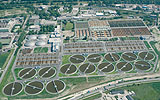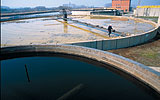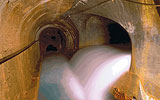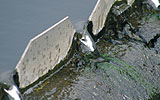The heavy price tag for clean water
Article in Danube Watch 02/2006

The heavy price tag for clean water
Some cities across the Danube River Basin are struggling to meet the staggering costs of complying with EU environmental regulations like the Urban Wastewater Treatment Directive.

Karlovac’s drinking water comes from wells that are being affected by the untreated human and industrial wastewater entering the local Mrežnica and Kupa rivers.
The 60,000 residents of Karlovac, Croatia, have never been happy about the untreated human and industrial wastewater entering the local Mrežnica and Kupa rivers. They’ve never liked the way it affects the groundwater sources used to supply the city’s drinking water, or local swimming, fishing and boating.
“Over the last ten years, some fish and crab have disappeared from my favourite fishing spot,” says local resident Ivica Kink. “They are both sensitive to pollution so wastewater was probably the reason.”
Karlovac residents wanted something done. The City of Karlovac is trying to bring them solutions. Besides local demands, other forces are driving improvements to local water quality. “Cities downstream aren’t pleased about inheriting upstream waste,” says Kresimir Veble, a manager at Karlovac’s water supply and wastewater treatment utility where he’s worked for 27 years. Croatia will also have to apply a strong set of EU water laws as part of its EU accession. These include the EU Water Framework Directive and Urban Wastewater Treatment Directive (UWWT).
The UWWT is designed to protect the environment from the adverse effects of wastewater. One requirement is that wastewater treatment should be ‘more stringent’ in ‘sensitive areas’ where water bodies are ‘eutrophic’ - deprived of oxygen and thereby suffocating and reducing biodiversity. ‘More stringent’ measures could mean introducing, at a utility, ‘tertiary treatment’ that removes nutrients. With Croatia now in the process of joining the EU, Karlovac is expected to be declared a ‘sensitive area’ and therefore in need of tertiary treatment.
“The UWWT could be the most expensive EU water quality requirement,” says ICPDR Technical Expert Mihaela Popovici. “In Romania, it could account for over 45% of the total costs for complying with EU environmental regulations.”

 One requirement of the EU Urban Wastewater Treatment Directive is that wastewater treatment should be more stringent where water bodies are eutrophic. This could mean introducing tertiary treatment at a utility to remove nutrients.
One requirement of the EU Urban Wastewater Treatment Directive is that wastewater treatment should be more stringent where water bodies are eutrophic. This could mean introducing tertiary treatment at a utility to remove nutrients.Bad nutrients. Nutrient pollution is a serious problem throughout the Danube River Basin (DRB), notes the ICPDR’s ‘Danube River Basin Analysis’ (Roof Report 2004). It has led to severe ecological damage in the Black Sea. Large parts of the DRB are at risk of not meeting the objectives of the EU Water Framework Directive because of excess nutrient pollution. Wastewater from cities is a major cause, as are agriculture and industry. Municipal wastewater also causes excessive organic pollution, another key issue identified by the ICPDR.
In response, measures to reduce nutrient and organic pollution will need to be taken by Danube countries through national management plans as well as their joint DRB Management Plan, coordinated by the ICPDR. An inventory of municipal wastewater treatment plants in the DRB is now being compiled that will provide information such as location, pollution loads, treatment technologies and cost efficiencies.
“From this data, we will be in a better position to identify the measures needed,” says Popovici. “These will include basic measures such as expanding utility capacity and improving technologies, and supplementary measures such as making sure regulations are in place, monitored and enforced. While suffi cient wastewater treatment has already been developed in Germany and Austria, major efforts are still required for central and lower Danube countries.”
“Because of these factors, Karlovac agreed to build a new wastewater treatment plant that includes tertiary treatment,” says Veble. “And the sewer network will be extended to more households. With significant costs.”
State to city. Not long ago, decisions affecting the Karlovac utility were made centrally by the state - typically the case for most former communist states in CEE. Now the city decides. Also, the utility needs to cover its own operating costs. It can do that if the prices it charges its customers bring in enough revenues. If Karlovac wants to invest in improved services, it will need more funds through grants or loans.
Karlovac will now receive a € 22.5 million grant from the EC’s Instrument for Structural Policies for Pre-Accession (ISPA) fund, a € 10 million loan from the European Bank for Reconstruction and Development (EBRD), and a € 3.5 million grant from the Government of Croatia for a total investment budget of € 36 million.
“We’re involved in a number of water and wastewater projects throughout CEE, having worked at the subsovereign level (lending to municipalities and municipal companies) for some time,” said Art Schankler, Senior Banker with the EBRD’s Municipal and Environmental Infrastructure Team. “If a project meets our criteria, then we’ll do our best to provide funding.” Criteria include a utility’s desire to switch to market economy practices and its ability to repay a loan. EBRD interest rates are comparable to the general market.
CASE STUDY: BELGRADE
About 1.5 million people live in Belgrade. All of the city’s wastewater is discharged into the local Sava and Danube rivers. Some local industries, however, have their own wastewater treatment facilities, expected to meet local regulations and standards for discharging into Belgrade’s sewer system.
“On average, the flow of the Danube in Belgrade is between five and six thousand cubic meters per second,” says Vladimir Tausanovic, Managing Director for Belgrade Waterworks and Sewerage. “The Danube is a strong recipient of Belgrade’s wastewater and there is therefore no significant environmental impact on river water quality.” After Belgrade, the Danube flows east increasing sediment volumes in the Iron Gates dam reservoir. The quality of water in the reservoir before the dam is below that of the water after the dam as it flows to the Black Sea.
A wastewater treatment was planned 30 years ago for Belgrade. According to the Belgrade Sewerage Master Plan, costs could reach more than half a billion euro. The city’s development department recently prepared a new Sewerage Master Plan in accordance with changes to the city’s new Urban Master Plan. The new Sewerage Plan calls for new monitoring systems, extending treatment services to municipalities without sewerage, and completion of the entire network of collectors, interceptors, pumping stations and treatment plants. One large central and four smaller treatment plants are envisioned. Only the plant planned for the settlement of Ostruznica, upstream from Belgrade’s water source, will include tertiary treatment – geared mainly to removing nutrient pollution.
“Since 2000, rehabilitation of the water supply and sanitation system, international development cooperation and institutional strengthening projects have all contributed to the success of improving services and decreasing costs in Belgrade,” says Tausanovic.
Cutting costs. Planning the design of the new infrastructure and equipment is one difficult task. This is the first time a Croatian utility will build a new plant that includes tertiary treatment, so there is no precedent. As engineers, Veble and his colleagues are prepared for this task. However, as they’re not really economists or financial experts, an even tougher job for them might be deciding on how to pay for the improvements.
“The first step is for utility managers to take an honest look at their true current costs and where they might be losing money now,” says Andras Kis, a consultant working on the ‘Tariffs and Charges Project’ of the UNDP/GEF Danube Regional Project (DRP) which has assisted officials in Karlovac. Reducing internal costs through reforms, such as reducing leakage from old pipelines, could lead to more money for new investments.
The EBRD’s Financial and Operational Performance
Improvement Program (FOPIP) will assist Karlovac to improve internal cost efficiencies. “The rationale is to reduce the risks of their not being able to repay the loan,” says Schankler. “By making operations as effi - cient as possible, for example through improved bill collections, costs will be lowered, service will improve and prices will be more affordable.”
Eliminating the big differences between prices charged to commercial and household customers is another EBRD goal. “Household prices were typically lower because it was easier politically to charge companies more,” says Schankler. “This raises the cost of doing business above the true costs of providing the service.” EBRD provided Karlovac with a ten year time frame to eliminate differences, while allowing that some differences could be justified (e.g. higher treatment costs for commercial waste). “Business, to be economically viable, should pay market prices. This benefits everyone.”

 “The first step is for utility managers to take an honest look at their true current costs and where they might be losing money now,” says Andras Kis, a consultant working on the ‘Tariffs and Charges Project’ of the UNDP/GEF Danube Regional Project. Reducing internal costs through reforms, such as reducing leakage from old pipelines, could lead to more money for new investments.
“The first step is for utility managers to take an honest look at their true current costs and where they might be losing money now,” says Andras Kis, a consultant working on the ‘Tariffs and Charges Project’ of the UNDP/GEF Danube Regional Project. Reducing internal costs through reforms, such as reducing leakage from old pipelines, could lead to more money for new investments.Deciding on a price. The next step is to determine how Karlovac will cover the added costs of fi nancing its new investments. What reforms will need to be taken? What will be the end service price charged to consumers?
This is very complicated given the broad range of different and simultaneous considerations affecting decisions. For example, after a new tertiary treatment facility is built, the costs to operate the overall utility will most likely increase. Another possibility is that if the utility charges its customers higher service prices in the future, they could respond by using fewer services, which would reduce overall revenues.
“What if new customers are added to the sewer network?” asks Veble. “What if the national currency exchange rate changes?”
As people like Veble and his colleagues lacked the necessary ‘financial modelling’ tools to assess these complex considerations, Karlovac was selected as a demonstration site for the DRP project. Pitesti in Romania is another pilot site (see box). The project raises awareness among utility managers about possible reforms for improving operational effectiveness. It has also developed a mathematical tool named ‘ASTEC’ to test the impacts of a range of simultaneous considerations on pricing.
“At the start, we input existing cost and revenue data from Karlovac into ASTEC,” said Kis. “One quick lesson learned was that the data was not ideal and improvements would need to be made, for example in collecting payments. It also showed utility managers how the process works.”
“Using a tool like ASTEC could benefit the Karlovac utility,” says Schankler. “Karlovac will be required by the EBRD to make five-year projections of costs and tariffs, so whatever assistance they get here would be good. The model could also help with eliminating differences between commercial and household prices.”
What does the future hold? “Once Karlovac identifies and selects the potential measures and reforms it might implement, then these can be fed into ASTEC,” says Kis. “ASTEC will then give them a range of various prices they can charge consumers for future services.” Hopefully, prices that consumers can afford.
TEST CASE: PITESTI, ROMANIA
A few years ago in Pitesti, Romania, the manager of the nearby Dacia car factory, Gelu Mujea, complained to the city’s mayor about the poor quality of local drinking water. Eventually, Pitesti’s mayor suggested to Mujea that he take over the city’s recently ‘localised’ local water service company ‘Apa Canal Pitesti’ and try to improve it himself. Mujea took on the challenge, was appointed General Manager of the company, and started on the long road to reform.
He introduced cost-saving measures such as automating treatment processes and reducing water use through the wide installation of water meters. He also took steps to increase revenues by improving the collection of bills and increasing prices. The savings and new revenues were used to make technological improvements for the drinking water treatment plant and water network. Pitesti now has both better quality water and a more reliable water service.
Mujea, his staff and City Council then applied for an EU ISPA grant and took out a loan from the European Investment Bank (EIB) – to extend the city’s sewer network, rehabilitate and upgrade the wastewater treatment plant, and further improve the drinking water facility. The new investments will be constructed by 2009.
To assist with financial planning, staff are now using the ‘ASTEC’ model provided by the UNDP/GEF Danube Regional Project (DRP). Together with DRP consultants, staff are using ASTEC to model the consequences of an array of expected changes, to come up with different price and investment scenarios.
“There are many opportunities to get international assistance to improve local services,” says Mujea. “We’re doing everything we can to take advantage of them.”





